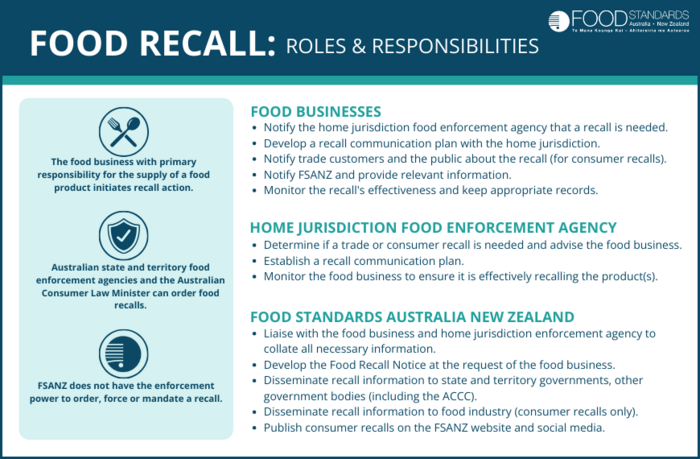A food recall is action taken by a food business to remove unsafe food from distribution, sale and consumption. All food businesses must be able to quickly remove food from the marketplace to protect public health and safety. FSANZ coordinates food recalls in Australia. In New Zealand, food recalls are coordinated by the Ministry for Primary Industries. FSANZ cannot order or force a recall because it has no enforcement powers. These powers rest with the jurisdictions. However most recalls are initiated by food businesses.
Please note: the information below applies only within Australia.
Find out about the latest food recalls
All consumer level recalls are listed on our Current recalls web page. You can also stay informed by subscribing to our food recall alert or liking us on Facebook or Instagram.
For more information about food recalls see below and our FAQs for consumers and FAQs for food businesses.
What to do if you need to recall a food
Follow your food recall plan. It is important to stop the distribution and sale of the product as soon as possible.
- Let your customers know about the recall and what they need to do (remove product from sale).
- Notify your local food enforcement agency and confirm what level the recall should be (consumer or trade).
- Call the FSANZ Recall Team and provide them with information about the recall. Contact FSANZ on (02) 6228 8226 and press #1 to speak with the FSANZ Recall Team.
- Decide how you will notify the public. This might be the local newspaper, your website or social media. This can be discussed with your food enforcement authority.
You will need to fill out the Food Recall Report and email (food.recalls@foodstandards.gov.au) as soon as possible.
The FSANZ recall team can help you through the process. For more information, visit our webpage on How to recall food, which explains the steps involved and provides links to useful templates.
How to prepare for a recall
FSANZ’s Food Recall Plan Template can help you develop your own recall plan in an easy to follow, quick reference style. This template should be used together with the Food Industry Recall Protocol, which provides more comprehensive guidance.
FSANZ's webpage on how to recall food is a useful resource for staff training and mock recalls.
All food manufacturers, importers and wholesale suppliers must have a written food recall plan, under clause 12 of Standard 3.2.2 – Food Safety Practices and General Requirements. The plan should cover the procedures, records and staff responsibilities a business needs in place for a food recall.
All food businesses should make sure their recall plan is correct, up to date and relevant for their particular operations.
Why is food recalled?
Food is recalled because of a report or complaint from manufacturers, wholesalers, retailers, government or consumers. It might also result from a food business’s own testing and auditing.
Recalls are classified according to the problem with the food. These problems can include:
- microbial – contamination with pathogenic microorganisms such as bacteria, viruses or parasites
- labelling – non-compliant labelling, incorrect food ingredients on the ingredient list, incorrect date markings or other food labelling errors
- foreign matter – contamination with material such as glass, metal or plastic objects
- chemical/other contaminants – contamination with substances such as cleaning products, pesticides, machine oil, etc
- undeclared allergen – due to incorrect labelling, incorrect packaging or contamination of the product by an allergen
- packaging fault – where an fault in the food packaging results in contamination (presence of glass/metal etc) of the food or a potential choking hazard
- biotoxin – contamination with biological toxins such as histamine in fish and paralytic shellfish toxin in oysters
- other – for example, unsafe levels of additives or presence of a therapeutic drug.
Types of food recalls
Food recalls can be at the trade or consumer level.
- A consumer recall is the most extensive type, recovering the food from all points in the production and distribution chain, including from consumers.
- A trade recall recovers food that has not been sold directly to consumers. It involves recovering the product from distribution centres and wholesalers, and may also include hospitals, restaurants or other catering establishments.
A food withdrawal is different from a food recall. It involves removing food from the supply chain where there is no public health or safety issue (e.g. if the product is underweight or has a quality defect).

